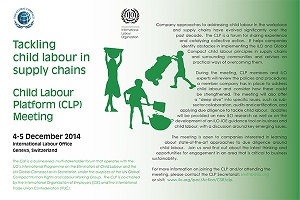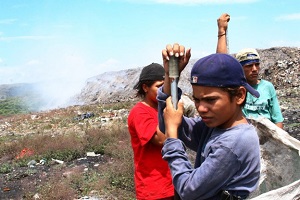The following ILO blog posted on 28 November 2014, by Benjamin Smith, ILO Senior Officer for Corporate Social Responsibility. He talks about the difficulties companies face while tackling child labour in their supply chains, The topic will be discussed at a meeeting hosted by the ILO on December 4-5.

Posted on November 28, 2014, by the International Labor Organization (ILO)
 |
| Benjamin Smith, Senior Officer for Corporate Social Responsibility International Programme on the Elimination of Child Labour |
The importance of employers in the worldwide movement against child labour has never been clearer. The corporate responsibility to respect human rights, including a child’s right to be free from child labour, is now widely recognized. Today, companies that don’t have a policy against child labour are outside the mainstream.
The challenge is to ensure that policy commitments achieve results — and this requires action on the ground, in workplaces and communities. I was in Blantyre, Malawi recently to train a company’s agronomists on combating child labour in agriculture. Every day, these agronomists — who are mostly young men and women — travel huge distances over rough terrain on Honda 125 motorcycles, visiting farms to advise farmers on when to plant, what fertilizers work best and when to harvest.
 |
| An upcoming meeting at the ILO looks at the challenges of helping companies identify obstacles in implementing child labour principles in supply changs. Find out more. |
Now they were being trained to watch out for child labour on farms, which mostly involves the children of farmers themselves, and to work with the farmers to find solutions.
After the training I asked one young agronomist what she thought, guessing that combating child labour was not what she signed up for when she took the job. Far from considering it a burden and one more task to be carried out during her visits, she told me that working to eliminate child labour was crucial, and that it would benefit the farmers and their families, as well as her company.
It was gratifying to hear her answer, and it bodes well for the company’s efforts to eliminate child labour in its supply chain. Providing training and other support to farmers, such as paying fair prices for crops, is an example of how companies can embed their policies against child labour into their core business.
What is the extent of a company’s responsibility? How can it ensure that it has the right policies and procedures in place to prevent child labour in its supply chains and take the necessary action if it occurs?
The challenge is tougher for companies that lack such an ability to directly influence the lowest parts of their supply chain. Supply chains are getting longer and more complex all the time. What’s more, child labour is concentrated in the informal economy and when suppliers sub-contract production to unregulated, informal enterprises it becomes much more likely that child labour may be involved.
In this complex context, what is the extent of a company’s responsibility? How can it ensure that it has the right policies and procedures in place to prevent child labour in its supply chains and take the necessary action if it occurs? How can it coordinate with other companies to share experiences and accelerate change in its industry? And how can it work with governments to support lasting solutions?
 |
| While it’s relatively straightforward for a company to ensure its direct suppliers don’t use child labour, making the same guarantee for other suppliers down the line can be much more difficult. |
These are some of the questions that companies put to the ILO’s International Programme on the Elimination of Child Labour. They ask for guidance to ensure that their policies are aligned with ILO Conventions and that their practices are effective in preventing and eliminating child labour.
One of the ways that we have responded is through the Child Labour Platform (CLP). This Platform, which operates under the auspices of the UN Global Compact Human Rights and Labour Working Group, brings companies, employers’ organizations, trade unions, ILO experts and others together for frank and open exchanges of experience about what works and what doesn’t.
It helps companies identify obstacles, but also good practices and solutions to overcoming hurdles. An ambitious research programme delves into some of the central challenges, such as age verification and child labour monitoring.
The next meeting of the CLP will take place on 4-5 December in Geneva and is open to all companies interested in learning about state-of-the-art approaches to due diligence around child labour.